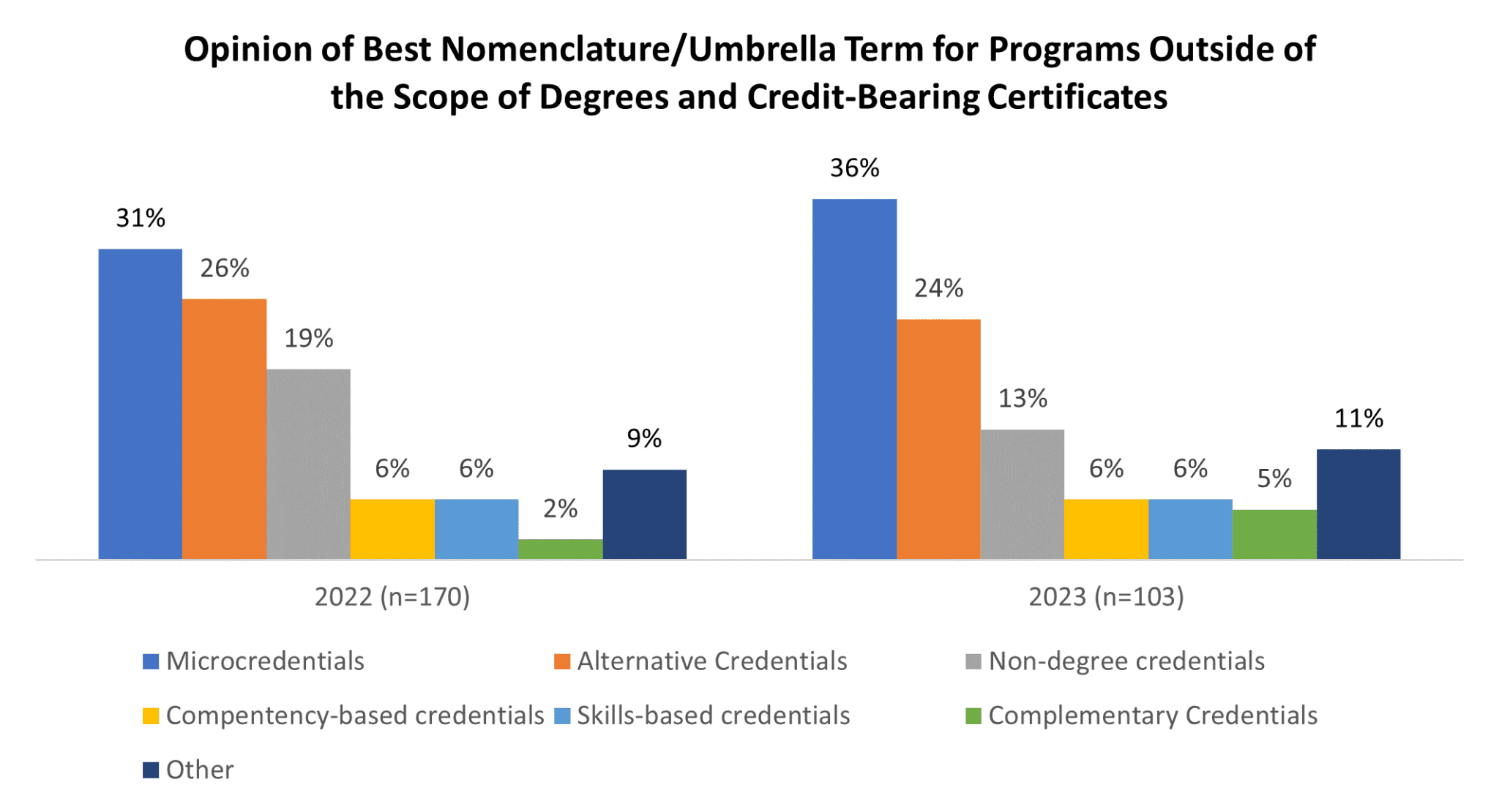We will scan the top Higher Education Marketing Blogs every few weeks and prepare a roundup for your knowledge and entertainment.
Think of it as your Cliffs Notes for Higher Education Marketing knowledge from around the web.
If you find we’ve left anybody that needs to be included, please drop us a line.
The synopses are AI-enabled, but the commentary is human.
All images are DALL-E representations of images from the articles synopsized.
What’s in a Name? Why Higher Education Needs to Standardize Nomenclature to Enable Programmatic Adoption
- October 18, 2023
- By: Bruce Etter, Senior Director of Research & Consulting, is responsible for developing and managing research initiatives for UPCEA Research and Consulting and its clients. He graduated from Penn State University with a Bachelor of Science in Sociology and a minor in Sustainability Leadership.
- Original Article

Overview
The article discusses the importance of standardized nomenclature in higher education, particularly in the context of non-degree credentials. Inconsistent naming within educational programs can lead to confusion and miscommunication, impacting program adoption and the perceived value of credentials. The author argues that engaging employers in credential development and establishing a chain of trust in the credential-issuing process can enhance the credibility of non-degree credentials.
Importance of Standardized Nomenclature in Higher Education
- Naming impacts perception and emotional associations.
- Consistency in labeling provides a sense of control and ownership.
- Disparity in program nomenclature triggers confusion and frustration.
- Clear comprehension of credentials and their value is crucial.
Employer Awareness and Engagement with Non-Degree Credentials
- Awareness drives adoption of non-degree credentials.
- Familiarity with credentials increases their usage by employers.
- Employers require proof of the effectiveness of programs.
- There are limited opportunities for collaboration with higher education institutions.
- Employer engagement in credential development can address credibility issues.
Advantages and Potential of Non-Degree Credentials
- Non-degree credentials can address limitations of traditional higher education.
- They can diversify revenue streams and establish new program pathways.
- They attract new learners looking for personalized and cost-effective options.
- Non-degree credentials fill the gap between degree programming and skills sought by employers.
- They enhance accessibility and flexibility for academic and professional growth.
Establishing Trust in Non-Degree Credentials
- Some HR professionals are skeptical about the rigor and comprehensiveness of non-degree credentials.
- Screening processes should determine the adequacy of non-degree training.
- Establishing a chain of trust in the credential-issuing process is important.
- The shift towards non-degree programming requires concerted trust-building efforts.
- Non-degree credentials should be seen as valuable preparation for positions.
The Role of Standardized Nomenclature in Higher Education Progress
- Consistent terminology enhances communication and understanding.
- It influences institutional policies, educational offerings, and the student learning experience.
- Standardized nomenclature promotes productive collaborations among institutions, students, and employers.
- Solidifying nomenclature is a fundamental step towards progress in higher education.
- Standardization fosters a cohesive and purpose-driven educational environment.
Unique or Noteworthy Positions
The author takes a unique position by emphasizing the need for standardized nomenclature in higher education, particularly non-degree credentials. They argue that inconsistent naming practices can lead to confusion and hinder program adoption, while standardized terminology can enhance communication and understanding, promoting progress in the sector. While not what we would think of as traditional among higher education marketing blogs, the naming of programs and their standardization can greatly impact student findability.
Gaining Deeper Insights into Stopped-Out Students
- October 17, 2023
- By: Jodi Ashbrook
- Original Article

Synopsis
Education Dynamics explores the complexities of “stopped-out” students, providing recommendations for understanding their needs, motivations, and potential strategies for re-enrollment.
Understanding Stopped-Out Students
- Stopped-out students face various barriers to re-enrollment, including financial difficulties and personal or family issues.
- There’s a slight gender disparity with women being predominant.
- Many of these students leave postsecondary education before they turn 25, with community colleges playing a crucial role in their retention.
- This group has a higher proportion of minority representation compared to current undergraduates.
- The 20-24 age group holds the most potential completers.
Motivations and Profiles of Stopped-Out Students
- Undergraduates are motivated by the prospects of finishing their degree, securing a better job, or pursuing their passion.
- Graduate stop-outs may have completed their undergraduate degree and started their careers, with motivations centered around advancing their careers, gaining new skills, or making a career change.
Strategies to Encourage Re-enrollment
- Re-enrollment is most likely within a year.
- Institutions should offer flexible program options, holistic support programs, and personalized outreach.
- Providing easily accessible programs with flexible schedules, meaningful experiences, and support from advisors or success coaches can encourage re-enrollment.
Tracking and Guiding Stopped-Out Students
- Comprehensive student records, academic histories, and enrollment data can be maintained using Student Information Systems (SIS).
- Personalized guidance through academic advising can track and support re-enrolled students.
- Regular meetings with re-enrolled students can monitor their academic journey and address challenges.
- Key performance indicators (KPIs) should be set and measured to assess student progress and identify improvement areas.
Intervention and Support for Stopped-Out Students
- Proactive intervention plans should be developed to help students facing academic difficulties.
- Degree audit systems can assist students in tracking their progress.
- Support services like tutoring, mentoring, and counseling are crucial to address specific student needs.
- Success stories of re-enrolled students should be showcased to motivate others.
- Collaboration with experts in student success coaching and consulting can help optimize resources and streamline processes.
The author emphasizes the importance of understanding the unique challenges stopped-out students face and providing effective support, regular communication, comprehensive student records, and regular check-ins. The use of blogs by higher education marketers is a great way to get the message out. The use of performance metrics and intervention plans is also highlighted. The article does not cite any background resources.
La Familia: Five ways institutions can support Hispanic families
- October 13, 2023
- By: Raquel Bermejo – Associate Vice President, Market Research and Planning
- Original Article

The article discusses multiple strategies that educational institutions can adopt to support Hispanic families and improve the educational outcomes of Hispanic students. These strategies focus on enhancing engagement, providing accessible information, building community partnerships, addressing financial concerns, offering personalized counseling and support, and promoting cultural celebrations and inclusion.
Engaging Hispanic Families in College Planning
- Emphasizing the value of education through workshops and informational sessions.
- Bridging the language gap through bilingual resources and communication channels.
- Collaborating with local Hispanic community organizations for tailored resources.
- Assigning dedicated admissions counselors who understand the challenges Hispanic students face.
Providing Accessible Information
- Providing bilingual resources and communications facilitated by technology.
- Offering clear financial aid guidance and workshops on the FAFSA.
- Explaining the benefits of education to Hispanic families.
Building Community Partnerships
- Establishing partnerships with local Hispanic community organizations.
- Providing resources such as workshops and mentoring programs through these partnerships.
- Creating opportunities for community engagement in college planning.
- Utilizing community networks for broader outreach.
Addressing Financial Concerns
- Providing comprehensive information about financial aid options.
- Conducting workshops on the FAFSA and connecting families with financial aid advisors.
- Ensuring information is clear, easy-to-understand, and deadlines are highlighted.
- Highlighting the long-term benefits of education and providing financial planning resources.
Personalized Counseling and Support
- Employing dedicated admissions counselors knowledgeable about Hispanic students’ challenges.
- Offering personalized guidance during the application process.
- Offering resources and referrals to additional support services.
- Continuously evaluating and improving counseling and support services for Hispanic families.
Importance of Family Support
- Recognizing that strong family support improves academic outcomes and mental health for Hispanic youth.
- Understanding that supportive families provide a sense of belonging and cultural identity.
- Providing resources and programs to promote family engagement.
Language Access and Communication
- Acknowledging language barriers and providing language access services.
- Investing in bilingual staff.
- Emphasizing culturally competent communication to build trust and understanding.
College Access and Success
- Focusing on increasing college access and success for Hispanic students to promote upward mobility.
- Providing information and resources about college preparation and financial aid.
- Offering mentorship programs and academic support services.
Mental Health and Well-being
- Prioritizing mental health awareness and providing culturally responsive services.
- Offering bilingual and culturally competent counseling services to address mental health disparities.
- Collaborating with community-based organizations to increase access to support.
Cultural Celebrations and Inclusion
- Celebrating and valuing Hispanic culture to foster a sense of belonging.
- Organizing cultural events and incorporating diverse perspectives in programming.
- Collaborating with Hispanic student organizations and community groups for authentic representation.
Unique or Noteworthy Positions
The author stresses the importance of bilingual resources, culturally responsive services, and community partnerships in supporting Hispanic families in pursuing higher education.
While We Were Watching ChatGPT, Something Else Astounding Emerged
- October 12, 2023
- By: Ray Schroeder
- Original Article
Ray Schroeder is Professor Emeritus, Associate Vice Chancellor for Online Learning at the University of Illinois Springfield (UIS) and Senior Fellow at UPCEA. Each year, Ray publishes and presents nationally on emerging topics in online and technology-enhanced learning. Ray’s social media publications daily reach more than 12,000 professionals. He is the inaugural recipient of the A. Frank Mayadas Online Leadership Award, recipient of the University of Illinois Distinguished Service Award, the United States Distance Learning Association Hall of Fame Award, and the American Journal of Distance Education/University of Wisconsin Wedemeyer Excellence in Distance Education Award 2016.
Digital Cloning
- Discusses the rise of deepfakes generated through deep learning, creating realistic fake images and videos
- Mentions Joanna Stern’s experiment with digital cloning and voice recognition tests to identify fake clones
- Raises concerns about potential misuse for identity theft and spreading misinformation
- Emphasizes the need to stay informed about advancements in digital cloning technology
The Metaverse
- Highlights Mark Zuckerberg’s announcement of the Metaverse and the criticism it received for its initial design
- Refers to Lex Fridman’s interview with Zuckerberg that showcases the capabilities of Meta technology
- Describes Codec Avatars and their realistic and spatial audio communication, which could potentially transform internet communication
- Discusses the possibility of a blend between digital and physical worlds to integrate AI and human interaction
Potential of the Metaverse in Education
- Suggests that the Metaverse could be a preferred platform for distance learning in higher education
- Discusses the potential for AI agents embodied in human avatars to enhance engagement
- Highlights how non-verbal communication and the overall learning experience could be improved in the Metaverse
- Notes the preparation required for the Metaverse to be integrated into education
- Envisions the Metaverse transforming the way teaching is done and providing immersive experiences
The Acceleration of Digital Innovation
- Observes the rapid advancements in digital innovation, particularly Generative Artificial Intelligence (GenAI)
- Acknowledges the progress in digital cloning and the Metaverse, and the challenge of keeping up with daily developments
- Discusses the opportunities and challenges these advancements pose across various sectors
Implications and Future Considerations
- Echoes concerns about authenticity and misinformation surrounding digital cloning
- Foresees a revolution in communication and collaboration through Metaverse avatars
- Raises questions about privacy, identity, and ethics as digital and physical worlds merge
- Predicts a reshaping of industries like education, entertainment, and social interactions through these technologies
- Stresses the need for society to address the implications and opportunities presented by digital cloning and the Metaverse
Noteworthy Positions Taken By The Author
- The author believes that while digital cloning raises concerns about authenticity and misinformation, it is important to stay informed about its advancements.
- The author suggests that the Metaverse could potentially revolutionize communication and collaboration, despite its initial criticism.
- The author underscores the potential of the Metaverse in education, particularly for distance learning and enhancing engagement.
- The author emphasizes the need for society to address the implications and opportunities of these digital advancements.
Background Resources Cited
- The Wall Street Journal’s article on Joanna Stern’s experiment with digital cloning
- Lex Fridman’s interview with Mark Zuckerberg on Meta technology
- Information and images regarding Codec Avatars and the Metaverse
- Various resources on Generative Artificial Intelligence (GenAI) and its significance in digital innovation.
The Crucial Role of Market Research to Compete in Higher Education
- October 12, 2023
- By: Brian Fortman – Vice President of Enrollment Management
- Original Article

The author emphasizes the importance of market research in higher education institutions for strategic decision making.
Impact on Enrollment
- Market research plays a crucial role in helping institutions understand their current market share.
- Predicting the impact of demographic changes on enrollment is possible through market research.
- Strategies to increase market share in key recruitment areas can be developed with the help of market research.
- Market research aids institutions in expanding into new markets.
- Understanding population and demographic changes is vital for mitigating enrollment impact.
Responsive Academic Programs
- Market research assists institutions in assessing the relevance and demand for their academic programs.
- Insights into prospective student interest in academic programs can be gained through market research.
- Institutions can align their academic program portfolio with the changing needs through market research.
- Market research aids in understanding labor market needs, helping institutions meet program demand.
- The institutional mission in program development is supported by market research.
Competitive Advantage
- Market research is key in understanding an institution’s position compared to competitors.
- Insights into institutional strengths and weaknesses in the market can be obtained through market research.
- Understanding dominant competitors and gaining a competitive edge is made possible through market research.
- Market research delivers key insights into what differentiates an institution from others.
- Strategies based on market research can be implemented to gain a competitive advantage.
Perception and Reputation
- Market research aids institutions in understanding how they are perceived in the market.
- It provides a direct way to assess the perception of the institution by students, families, and industry.
- Valuable insights can be gained through qualitative and quantitative market research.
- Understanding perception supports strategic decision-making.
- Building a positive reputation is assisted by market research.
Strategic Pricing
- Understanding student and family responsiveness to price changes is aided by price sensitivity research.
- Balancing revenue needs with student willingness to pay is possible through market research.
- Market research assists institutions in thinking strategically about price changes.
- Understanding market tolerance for price changes is crucial.
- Price sensitivity analysis ensures pricing decisions are aligned with market demand.
The Power of CPI in Higher Education
- October 10th, 2023
- By: Ren Horst
- Original Article

Synopsis
Search Influence and UPCEA are presenting a webinar on The Power of CPI to Measure Higher Ed Marketing Success. CPI (Cost Per Inquiry) is a tool used to assess the success of digital marketing in the higher education sector.
Key Points
- CPI helps determine marketing spend outcomes and allows comparison of results with industry standards.
- It’s a tool that can evaluate the realism of promises from third-party vendors.
- However, many higher education marketers struggle with calculating CPI.
- The webinar aims to teach different methods of measuring CPI, how to utilize existing data in CPI calculations and tips for overcoming challenges in capturing CPI.
- Participants will get access to a free worksheet for easier CPI calculation and an opportunity to participate in a survey establishing a benchmark for higher-ed CPI.
- The presenters include Jim Fong and Bruce Etter from UPCEA and Paula French and Alison Zeringue from Search Influence.
Live Attendance Perks
- Live attendees will get an exclusive chance to win prizes.
- The prizes include a $200 credit to a global reward catalog and a free professional CPI analysis with Search Influence.
Search Influence & UPCEA Partnership
- Search Influence is a Platinum Partner of UPCEA since 2022.
- The Power of CPI to Measure Higher Ed Marketing Success is another initiative by the partnership aiming to help higher education marketers think smarter about their success.
Unique or Noteworthy Positions
- The article emphasizes the importance of CPI in measuring marketing success in higher education.
- It highlights the struggle many higher education marketers face in calculating CPI and offers a solution through the webinar.
Background Resources
- UPCEA- University Professional & Continuing Education Association
- More Higher Education Blogs at Search Influence
3 Universities that Stand Out from the Crowd
- October 10, 2023
- By: Anne Albanese
- Original Article

Article Synopsis
This article highlights the unique features of three universities: Franklin and Marshall College, St. Johns College, and Brigham Young University (BYU). It also discusses the unique marketing tactics utilized by BYU.
Franklin and Marshall College
- Specializes in unique housing options:
- About 20% of students live in subject-based houses.
- Housing assignments are based on a year-long intensive writing seminar.
- The college has five interest-specific houses: Bonchek, Brooks, Roschel, Ware, and Weiss.
- Each house has a faculty member and traditional resident advisors.
- The houses foster a sense of belonging and community.
St. Johns College
- Offers a unique curriculum:
- Provides a broad classic education.
- Focuses on critical thinking and writing.
- Students graduate with a Bachelor of Arts in Liberal Arts.
- Involves shared reading of about 200 great books.
- Offers diverse career opportunities for graduates.
Brigham Young University
- Emphasizes religion:
- Founded, supported, and guided by The Church of Jesus Christ of Latter-day Saints.
- Religion is central to the university’s mission and values.
- LDS beliefs and principles are incorporated into the academic and social environment.
- Offers a wide range of religious courses and activities.
- Students are expected to follow an honor code based on LDS teachings.
BYU’s Unique Marketing Tactics
- Uses diverse strategies to reach its target audience.
- Markets through music streaming services, podcasts, and YouTube.
- Advertises in airports, news websites, billboards, and LinkedIn to reach potential employers.
- Posts ads and sponsored content on YouTube, Spotify, Pandora, and YouTube Music.
- Uses its a cappella groups, BYU Vocal Point and BYU Noteworthy, for promotion.
Background Resources
- ‘What’s Your Institution’s McDonald’s Order?’: Not provided
- ‘Minerva University: Wisdom Through Experience’: Not provided
- ‘Northern Pennsylvania Regional College Caters to the Non-traditional Student’: Not provided
Author’s Position
The author does not take a unique or noteworthy position but presents a factual overview of the universities’ unique features and marketing tactics.
EdTech Industry Trends: 2021 and Beyond
- Article by Orion Team, Published on Thinkorion.com
- Original Article
Current Landscape and Global Reach of EdTech
- The edtech sector is seeing rapid expansion, with the number of internet users expected to reach 5.19 billion by 2023.
- The global e-learning market is projected to reach nearly 400 billion U.S. dollars by 2026.
- The education software market is expected to reach 11.6 billion dollars by 2025.
- Key players in the edtech industry include Byjus, BetterUp, Guild Education, Articulate, Course Hero, Handshake, GoStudent, UnAcademy, Erudits, and ApplyBoard.
Personalized Learning
- Adaptive learning platforms and AI-driven personalized recommendations are becoming popular in the education sector.
- These technologies adapt curriculum based on a learner’s performance and are setting a new baseline for higher education.
Online and Blended Learning
- The number of users in the online learning platforms market is set to reach 4.8 million by 2027.
- Blended learning, which combines in-class and online learning, is becoming increasingly prevalent.
Gamification and Immersive Learning
- Edtech platforms are incorporating gamified learning experiences, such as scorecards, leaderboards, and trophies, to drive higher student engagement.
- Immersive learning environments, including VR and AR, are making education more captivating and effective.
Data Analytics and Learning Analytics
- Learning analytics and data mining techniques are being used to identify trends and personalize instruction.
- These technologies foster a data-informed, student-centered approach in education.
EdTech in K-12 Education
- Edtech in K-12 education emphasizes personalized learning, data analytics, and AI-driven adaptive learning platforms.
- This technology effectively meets student demands and supports teachers.
EdTech in Higher Education and Corporate Training
- Online degree programs and MOOCs are gaining popularity in higher education.
- Technological innovations like gamification, blockchain, chatbots, IoT, CRM, and LMS are playing a significant role.
- Hybrid models of online and in-person activities are bringing interactivity and flexibility to higher education institutions.
- Edtech is transforming how corporations train and evolve professionally.
Noteworthy positions taken by the author
- The author emphasizes the rapid expansion and global reach of edtech, driven by increasing internet usage and the growth of the e-learning and education software markets.
- The author highlights the impact of personalized learning, online and blended learning, gamification, and immersive learning on the education sector.
- The author suggests that edtech is transforming K-12 education, higher education, and corporate training, with a strong emphasis on data analytics and AI-driven adaptive learning platforms.
HighEdWeb 2023 Presentation by Element451
- By: Sirley Carballo
- Original Article
Element451 is a company that provides software solutions for student engagement and enrollment to schools. The platform leverages artificial intelligence capabilities and offers various features including BoltBot and Copilot, communication automation, applications and events management, and the ability to create pages and sites. Additionally, it provides insights and analytics for data-driven decision-making.
Overview of Element451
- Provides software for student engagement and enrollment in schools.
- Incorporates AI capabilities.
- Provides various pricing options.
- Has a list of customers in the education sector.
- Provides career opportunities.
Features of Element451’s Software
- Key features include BoltBot and Copilot.
- Offers communications automation.
- Includes applications and events management.
- Allows creation of pages and sites.
- Provides insights and analytics for data-driven decision-making.
Resources Provided by Element451
- Offers AI resources.
- Focuses on student engagement.
- Runs a blog with relevant content.
- Provides webinars to educate users.
- Publishes guides and white papers for reference.
Element451’s Online Presence
- Can be followed on social media platforms.
- Offers a newsletter for subscribers.
- Provides contact information for inquiries.
- Reserves all rights.
The article also highlights a presentation by Element451 showcased at HighEdWeb 2023. The presentation provides insights into integrating AI into recruitment strategies, making it a valuable resource for the education sector. The focus of the presentation is on enhancing recruitment strategies.
HighEdWeb 2023 Presentation
- The presentation is about integrating AI into recruitment strategies.
- It was showcased at HighEdWeb 2023.
- It is targeted at the education sector.
- The focus is on enhancing recruitment strategies.
The article does not cite any background resources or take any unique or noteworthy positions.
